Components of Food Class 6 Worksheet Science Chapter 1
| Table of contents |

|
| Q1. Fill in the Blanks |

|
| Q2. State True or False |

|
| Q3. Short Answer Questions |

|
| Q4. Assertion and Reason Questions |

|
| Q5. Multiple Choice Questions (MCQs) |

|
Q1. Fill in the Blanks
(i) ______ and ______ mainly provide energy to our body.
Ans: Carbohydrates, fats
 View Answer
View Answer 
Carbohydrates and fats are the primary sources of energy. Carbohydrates provide quick energy, while fats provide stored energy that can be used when needed.
(ii) A ______ can prevent deficiency disease.
Ans: Balanced diet
 View Answer
View Answer 
A balanced diet includes all essential nutrients in the correct proportions, which helps maintain health and prevent deficiency diseases.
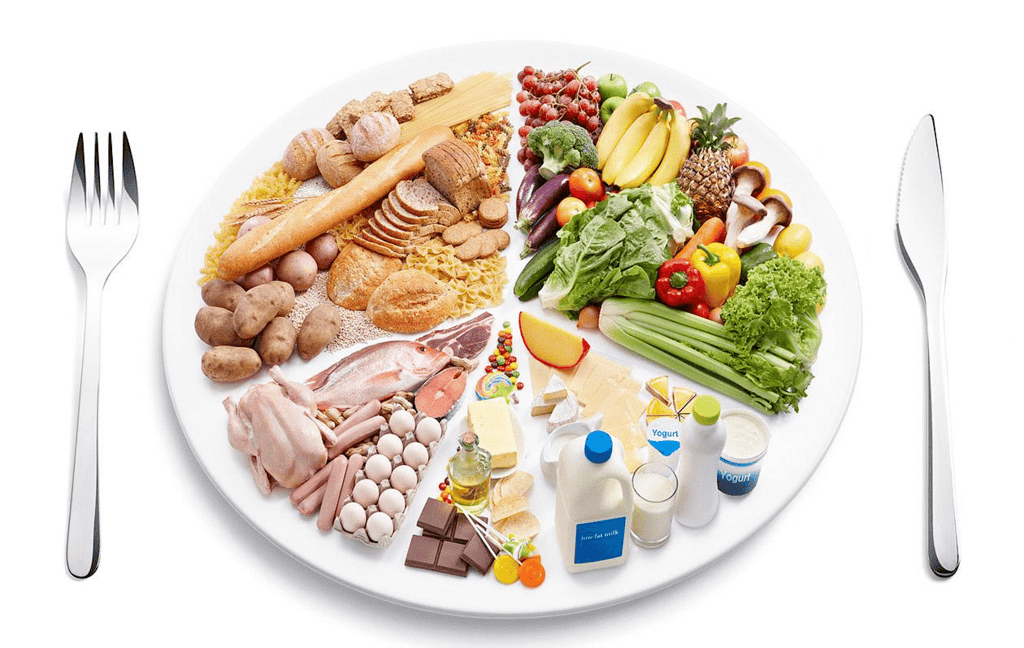 Balanced Diet
Balanced Diet
(iii) Too much fat in the diet may lead to ______.
Ans: Obesity
 View Answer
View Answer 
Excessive consumption of fats can lead to fat accumulation in the body, resulting in obesity.
(iv) Cooking in too much water destroys ______ in food.
Ans: Nutrients
 View Answer
View Answer 
Cooking food in excess water dissolves many nutrients, particularly water soluble vitamins, in the water. When the extra water is thrown away, the nutrients dissolved in the water are also lost.
(v) ______ gets easily destroyed by heat during cooking.
Ans: Vitamin C
 View Answer
View Answer 
Vitamin C is sensitive to heat and can be easily destroyed during cooking processes.
(vi) Deficiency of Vitamin D causes ______.
Ans: Rickets
 View Answer
View Answer 
Rickets is a disease caused by a deficiency of Vitamin D, leading to weak and soft bones.
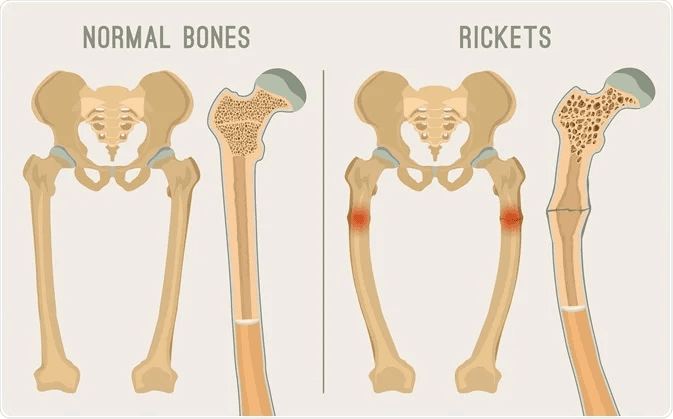 Rickets
Rickets
(vii) Deficiency of Vitamin C causes ______.
Ans: Scurvy
 View Answer
View Answer 
Scurvy is caused by a deficiency of Vitamin C, leading to symptoms such as bleeding gums and weakness.
(viii) ______ makes up about 70% of our body weight.
Ans: Water
 View Answer
View Answer 
Water is a crucial component of the human body, constituting around 70% of its weight.
 Water is essential for body
Water is essential for body
(ix) ______ is mainly responsible for the transportation of nutrients in our body.
Ans: Water
 View Answer
View Answer 
Water acts as a medium for transporting nutrients, oxygen, and waste products throughout the body.
(x) ______ is essential for the production of hemoglobin in the blood.
Ans: Iron
 View Answer
View Answer 
Iron is a key component of hemoglobin, which is necessary for transporting oxygen in the blood.
Q2. State True or False
(i) Milk does not provide dietary fiber.
Ans: True
 View Answer
View Answer 
Milk is a good source of calcium and other nutrients but does not contain dietary fiber.
(ii) Fats provide less energy as compared to the same amount of carbohydrates.
Ans: False
 View Answer
View Answer 
Fats provide more energy (9 calories per gram) compared to carbohydrates (4 calories per gram).
(iii) Lack of nutrients in our diet over a long period causes deficiency diseases.
Ans: True
 View Answer
View Answer 
Prolonged deficiency of essential nutrients can lead to various deficiency diseases.
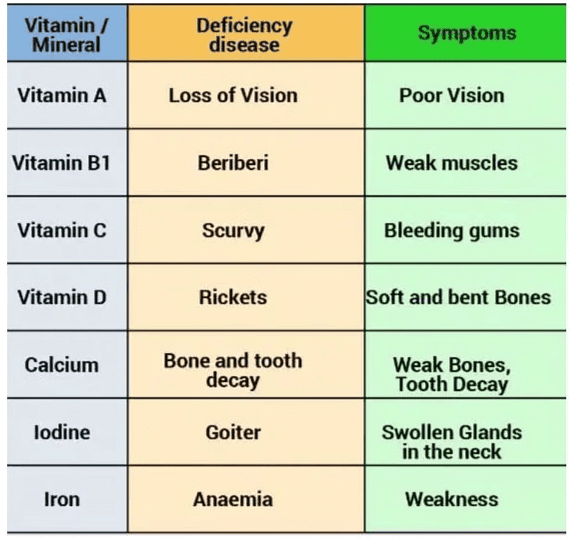 Deficiency Diseases
Deficiency Diseases
(iv) Rice and potatoes are rich in protein.
Ans: False
 View Answer
View Answer 
Rice and potatoes are primarily rich in carbohydrates, not proteins.
(v) Peas, gram, soya beans, and cottage cheese are good sources of proteins.
Ans: True
 View Answer
View Answer 
These foods are rich in proteins and are often included in diets to meet protein requirements.
Q3. Short Answer Questions
Q1: Name the deficiency disease that causes bleeding gums.
Ans: Scurvy is a deficiency disease that leads to bleeding gums. It occurs due to a lack of Vitamin C in the diet.
- Symptoms include:
- Bleeding gums
- Slow healing of wounds
To prevent scurvy, it is important to consume a balanced diet rich in fruits and vegetables.
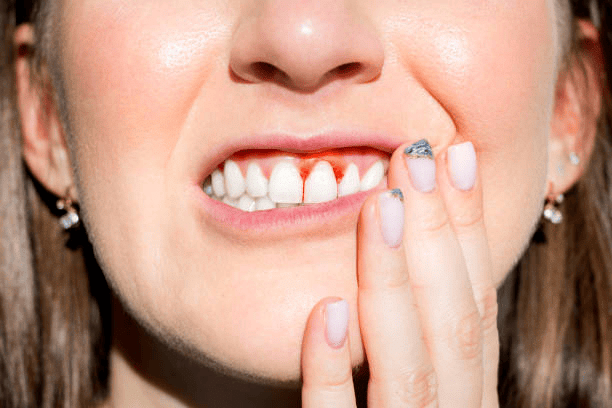 Bleeding Gums: Scurvy
Bleeding Gums: Scurvy
Q2: Name the deficiency disease that is caused by the deficiency of iron in the diet.
Ans: Deficiency disease caused by iron deficiency:
The deficiency disease resulting from a lack of iron in the diet is known as anaemia.
- Anaemia leads to fatigue and weakness.
- It can cause pale skin and shortness of breath.
- Iron is essential for producing haemoglobin, which carries oxygen in the blood.
Q3: What is the vitamin that represents a group of other vitamins?
Ans: Vitamin B-complex represents a group of essential vitamins that work together to support various bodily functions.
- Includes several vitamins, such as Vitamin B1, Vitamin B2, Vitamin B3, and others.
- Plays a crucial role in energy production and the formation of red blood cells.
- Supports the health of the nervous system.
- Helps maintain healthy skin and hair.
Our body requires all types of vitamins, including those in the B-complex, to function properly.
Q4: What is obesity?
Ans: Obesity is a condition where excessive fat accumulates in the body, leading to being overweight. It is caused by consuming more calories than the body needs.
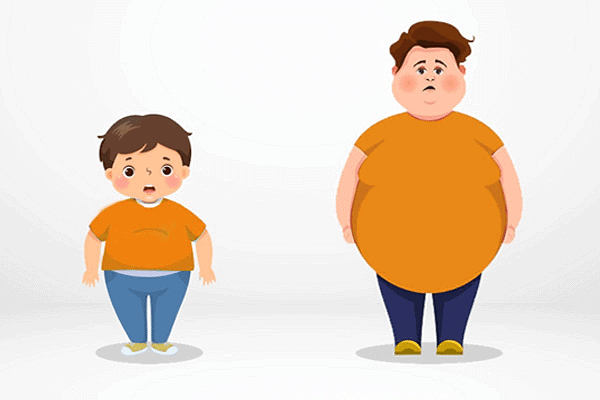 Obesity
Obesity
Q5: Why do we need carbohydrates in our diet?
Ans: Carbohydrates are essential in our diet for several reasons:
- They are the primary source of energy for our body.
- Carbohydrates help fuel our daily activities and bodily functions.
- They are found in many common foods, such as bread, rice, and pasta.
Including an adequate amount of carbohydrates in our meals is important for maintaining overall health.
Q6: Why do children need more protein in their diet?
Ans: Children require more protein in their diet for several important reasons:
- Growth: Protein is vital for the overall growth of children.
- Development: It supports the development of muscles, tissues, and organs.
- Repair: Protein aids in the repair of body tissues.
- Immune Function: It plays a role in maintaining a healthy immune system.
Ensuring adequate protein intake helps children grow strong and healthy.
Q7: Dia prepared ladyfingers that tasted yummy. She washed the ladyfingers after cutting them into small pieces, then fried them in excess oil with various spices to make them crunchy and flavorful. Was her method of cooking correct?
Ans:
- No, Dia's method of cooking the ladyfingers wasn't ideal. Washing ladyfingers after cutting can make them slimy due to the release of their sticky sap, making them harder to cook properly.
- To avoid this, it's best to wash the ladyfingers first, dry them thoroughly, and then cut them into pieces.
- Additionally, using excessive oil is unnecessary and can make the dish heavy.
- Instead, frying them with a moderate amount of oil and spices would make them crunchy and flavorful without being too oily.
Q8: What is night blindness? Write its symptoms.
Ans: Night blindness is a condition where a person finds it difficult to see in low light conditions or complete darkness. Symptoms include poor vision at night or in dim light.
Q9: A child has stunted growth, swelling on the face, discoloration of hair, and skin disease. He was advised to eat a protein-rich diet. Name the disease the child is suffering from.
Ans: The child is suffering from Kwashiorkor, which is a disease caused by a lack of protein in the diet.
- Symptoms include:
- Stunted growth
- Swelling of the face
- Discolouration of hair
- Skin diseases
- A protein-rich diet is essential for recovery.
Q10: How can we test the presence of fat in food items?
Ans: To test for the presence of fat in food items, follow these steps:
- Take a small piece of the food item.
- Wrap it in a piece of paper and crush it gently, ensuring the paper does not tear.
- Straighten the paper and observe it closely.
- Check for an oily patch on the paper.
- Hold the paper up to the light. If you can see light faintly through the patch, it indicates the presence of fat.
Note that if the paper does not show an oily patch after drying, the food item likely does not contain any fat.
Q11: How are diseases caused?
Ans: Diseases can arise from various factors, including:
- Lack of nutrients: Insufficient intake of essential nutrients can lead to deficiency diseases.
- Infections: Bacteria, viruses, and other pathogens can cause illnesses.
- Unhealthy lifestyle choices: Poor diet, lack of exercise, and smoking can contribute to disease development.
Deficiency diseases occur when the body lacks specific nutrients for an extended period. For example:
- Protein deficiency: Can cause stunted growth, skin issues, and digestive problems.
- Vitamin deficiencies: Such as Vitamin A leading to vision loss, or Vitamin C causing scurvy.
To prevent these diseases, it is crucial to maintain a balanced diet that includes a variety of nutrients.
Q12: Write the steps to test the presence of protein in a food item.
Ans: Steps to test for protein:
- Grind or mash the food item.
- Put it in a test tube and add 10 drops of water.
- Add two drops of copper sulfate solution.
- Add ten drops of caustic soda solution.
- Shake well and observe if the solution turns violet, indicating the presence of protein.
Q13: What is a balanced diet? Is it the same for everyone?
Ans: A balanced diet includes all the nutrients in the right amounts, along with adequate roughage and water. It is not the same for everyone as nutritional needs vary based on age, gender, and activity level.
Q14: How can we cure anemia?
Ans: Anemia can often be treated effectively depending on the underlying cause. By increasing the intake of iron-rich foods like leafy greens, meat, and fortified cereals, and in some cases, taking iron supplements.
Q15: On adding 2-3 drops of dilute iodine solution to a food item, it turns blue-black. What does it indicate?
Ans: Adding 2-3 drops of dilute iodine solution to a food item that turns blue-black indicates the presence of starch in that food.
Q16: Why is sunlight important for our health?
Ans: Sunlight plays a crucial role in our health by enabling our body to produce Vitamin D. This vitamin is vital for:
- Maintaining healthy bones and teeth.
- Supporting the immune system.
- Regulating mood and mental health.
However, many people today suffer from Vitamin D deficiency due to insufficient exposure to sunlight.
 Sunlight gives us Vitamin D
Sunlight gives us Vitamin D
Q17: "Vitamins and minerals are essential in very small quantities for our body compared to other components, but they remain an important part of a balanced diet." Explain the statement.
Ans: Vitamins and minerals are needed in very small quantities but are essential for the normal functioning of our body. This is because of the following reason:
- They are protective foods and help protect our bodies against diseases.
- They help in maintaining good health.
- They help in the normal growth of our body.
Q18. Name the food materials that contain fat.
Ans: The food materials which contain fat are:
- Ghee
- Butter
- Cheese
- Egg
- Meat
- Milk
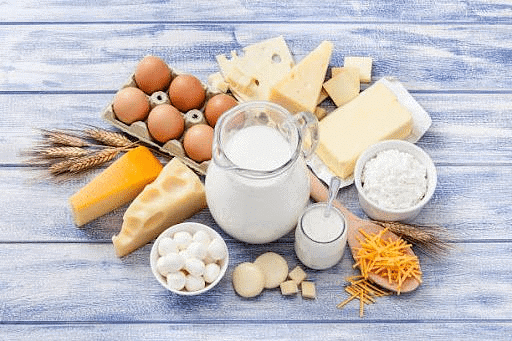 Food Products derived from Animals
Food Products derived from Animals
Q4. Assertion and Reason Questions
Q1: Assertion (A): Foods containing proteins are called body building foods.Reason (R): Paneer is a plant source of protein.
(a) Both A and R are true and R is the correct explanation of A.
(b) Both A and R are true but R is not the correct explanation of A.
(c) A is true but R is false.
(d) A is false but R is true.
Ans: (c) A is true but R is false.
 View Answer
View Answer 
- Foods containing proteins are indeed called body-building foods because proteins are essential for the growth and repair of body tissues.
- However, paneer is not a plant source of protein; it is an animal product made from milk.
Q2: Assertion (A): Obesity occurs when one takes more food than required.
Reason (R): The extra food gets stored as fat and the person becomes too fat.
(a) Both A and R are true and R is the correct explanation of A.
(b) Both A and R are true but R is not the correct explanation of A.
(c) A is true but R is false.
(d) A is false but R is true.
Ans: (a) Both A and R are true and R is the correct explanation of A.
 View Answer
View Answer 
- When a person consumes more calories than their body needs, the excess calories are stored as fat, leading to obesity.
- The reason provided accurately explains why the assertion is true.
Q3: Assertion (A): Deficiency of calcium causes rickets.
Reason (R): In our diet, milk and milk products are the major sources of calcium.
(a) Both A and R are true and R is the correct explanation of A.
(b) Both A and R are true but R is not the correct explanation of A.
(c) A is true but R is false.
(d) A is false but R is true.
Ans: (b) Both A and R are true but R is not the correct explanation of A
 View Answer
View Answer 
- Deficiency of calcium can lead to rickets, a disease that affects bone development in children.
- While milk and milk products are significant sources of calcium, they are not the only sources, so the reason is correct but not a comprehensive explanation of the assertion.
Q4: Assertion (A): Vitamins are required in small quantities for maintaining good health.
Reason (R): Vitamins help protect our body against diseases and keep our bones, teeth, and gums healthy.
(a) Both A and R are true and R is the correct explanation of A.
(b) Both A and R are true but R is not the correct explanation of A.
(c) A is true but R is false.
(d) A is false but R is true.
Ans: (a) Both A and R are true and R is the correct explanation of A.
 View Answer
View Answer 
- Vitamins are indeed required in small quantities for maintaining good health, and they play a crucial role in protecting the body against diseases and maintaining the health of bones, teeth, and gums.
- The reason provided accurately explains the assertion.
Q5. Multiple Choice Questions (MCQs)
Q1: Which of the following nutrients mainly provides energy to our body?
(a) Proteins
(b) Carbohydrates
(c) Vitamins
(d) Minerals
Ans: (b) Carbohydrates
 View Answer
View Answer 
Carbohydrates are the primary source of energy for the body.
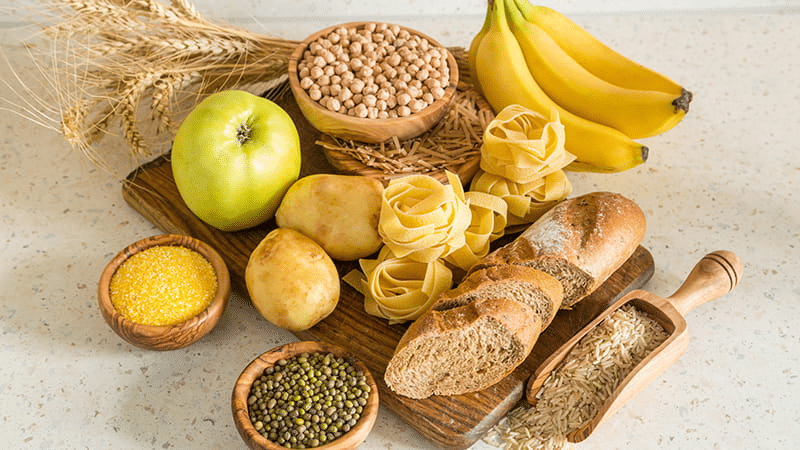 Sources of Carbohydrates
Sources of Carbohydrates
Q2: What test is used to check the presence of protein in a food item?
(a) Iodine solution test
(b) Copper sulfate and caustic soda test
(c) Paper test
(d) Lime water test
Ans: (b) Copper sulfate and caustic soda test
 View Answer
View Answer 
The copper sulfate and caustic soda test, also known as the Biuret test, is used to detect proteins in a food item.
Q3: Which vitamin deficiency causes night blindness?
(a) Vitamin A
(b) Vitamin B
(c) Vitamin C
(d) Vitamin D
Ans: (a) Vitamin A
 View Answer
View Answer 
Deficiency of Vitamin A can lead to night blindness, where the person has difficulty seeing in low light conditions.
Q4: Which of the following foods is a good source of Vitamin C?
(a) Milk
(b) Liver
(c) Orange
(d) Rice
Ans: (c) Orange
 View Answer
View Answer 
Oranges are rich in Vitamin C, essential for the immune system and skin health.
Q5: What happens if excess water is used during cooking and then thrown away?
(a) It improves the taste of the food
(b) It helps in retaining vitamins
(c) It results in the loss of minerals and vitamins
(d) It increases the fat content
Ans: (c) It results in the loss of minerals and vitamins
 View Answer
View Answer 
Using excess water during cooking and then discarding it can lead to the loss of water-soluble vitamins and minerals.
FAQs on Components of Food Class 6 Worksheet Science Chapter 1
| 1. What are the main components of food? |  |
| 2. Why do we need carbohydrates in our diet? |  |
| 3. What role do proteins play in our body? |  |
| 4. How do vitamins and minerals contribute to our health? |  |
| 5. What are some examples of foods rich in fats, and why are they important? |  |
















